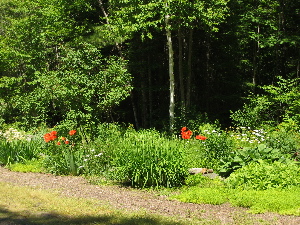DYING TREES BY ROADSIDES
We’ve all seen them. As we drive along the road we see dead or dying trees. It always brings the comment, or question: “I wonder what causes that?” As gardeners, it would be good to know!
Here’s a very probable solution that was put forth by G.W. Hudler from Cornell University. I saw this little article in the New Hampshire Community Forestry Advisory Council newsletter back in the spring of 2004.
He talks about the fact that although there may be many possible contributing factors to this die-off, most likely it is caused by salt.
The corrosive effects salt has on automobiles also play havoc on plant materials, like trees. We all know that up here in our snow ridden climate, roads are “sprinkled” with chemicals, most often salt and that when it washes off the road, it goes right to the roots of those plants. Also, when the cars and trucks go flying by, they spray that same chemical concoction onto the leaves of the trees and plants growing close by the road.
“One of the primary causes of salt injury to plants is high salt accumulation in the soil near a plant’s root system. If you have ever tried to shake salt from a wet shaker, you know it’s virtually impossible-because salt absorbs water. Salt has the same properties in soil and can actually absorb much of the water that would normally be available to plants. As a result, even when soil moisture levels are high, salt can cause drought-like conditions for plants.
“Salt can also be directly absorbed by plant cells when plants are sprayed from passing vehicles. When this happens, cold hardiness may be reduced leaving plants more susceptible to freezing.
“In addition to the direct effects of salt, salt injured plants are weaker and more susceptible to insects, diseases, and environmental factors contributing to their decline or death.”





4 Comments:
Talking of dying trees .... whilst talking to the man who rotary hoed our lawns a few weeks ago, we got onto the subject of dying trees and how long it was taking the Department of Urban Services to remove them. John said that he often did work in various capacities for the Dept. and he knew that there were at least 6000 trees in this city (pop. 320,000) that had died due to the continuing drought, and that's just the ones that the Dept. knew about.
Losing a small plant or shrub is bad enough, but losing a mature tree is tragic.
Alice, what city are you talking about?
Our climates are pretty fragile!
I think perhaps we all need to go see the new movie with Al Gore, "An Inconvenient Truth".
Good luck with those trees.
I'm talking about my home city of Canberra in the South-east of Australia. Most of our tree losses are due to drought and the lowering of the water table. In some other areas of the country the land is becoming degraded through salt, but not because it's put on the roads; I think it has something to do with irrigation. I must find out.
Depending on where you live, dead trees are a sign of various bugs and blights, all introduced from other shores.
Right now the midwest is losing it's Ash trees to the Emerald Ash Borer. There is a quarantine, and they are busy removing the afflicted trees as fast as they can find them, but I've a bit of cynacism that it can be stopped.
They've found evidence of the borers in Central Park, New York City, well outside of the midwestern states that are under the quarantine.
Post a Comment
<< Home